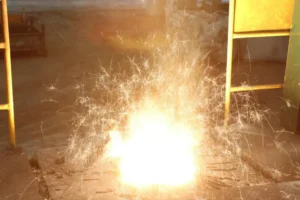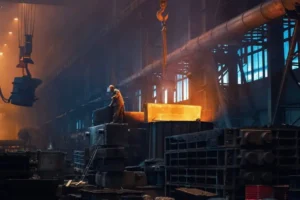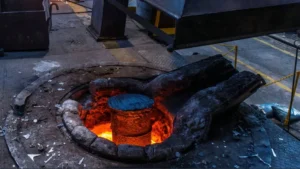When Induction Heating is mentioned, you might first think of the massive furnaces in factories used for melting metal. But in reality, this “magical” technology has long penetrated our daily lives, quietly changing our cooking and even modern manufacturing in a highly efficient, clean, and precise way.
It isn’t just limited to heavy industry; from your kitchen stove to the manufacturing of precision instruments, the applications of induction heating are far more wonderful and widespread than you might imagine.
The “Magician” in the Kitchen, The Induction Cooktop
The most outstanding representative of induction heating in daily life is undoubtedly the induction cooktop (IH stove).
Have you ever wondered why the surface of an induction cooktop doesn’t get scorching hot (or only gets hot from the heat conducted by the pot), yet it can rapidly bring the water inside the pot to a boil?
This is the magic of induction heating. The principle can be understood simply as:
- Generating a Magnetic Field: Inside the cooktop, there is a copper coil. When an electric current passes through the coil, it generates a high-frequency alternating magnetic field.
- Inducing Current: When you place a ferromagnetic pot (like an iron or stainless steel pot) on the cooktop, this changing magnetic field passes through the bottom of the pot, causing powerful eddy currents to form within the pot’s metal.
- Generating Heat: Metal itself has electrical resistance. As these powerful eddy currents “race” around the bottom of the pot, they generate a large amount of heat (Joule heating) due to this resistance, causing the “pot to heat itself.”
The Wonder of It:
- High Efficiency & Energy Saving: The heat is generated directly at the bottom of the pot, with almost no heat loss to the surrounding air. Its thermal efficiency is far higher than traditional open flames or electric heating elements.
- Precise Temperature Control: By adjusting the frequency and intensity of the current, the “flame” size can be controlled instantly and accurately.
- Safety & Cleanliness: No open flames, no exhaust fumes. The cooktop surface is easy to clean, greatly enhancing kitchen safety and comfort.
More Than Just Melting, The “Precision Scalpel” of Industry
While the induction cooktop is the example we are most familiar with, the industrial applications of induction heating, especially in metal heat treatment, truly demonstrate its “wonderful” controllability. It’s no longer just about crude melting; it’s like a precise “surgical scalpel.”
1.Surface Hardening
Many mechanical parts (like gears, bearings, and machine tool guides) need to be “hard on the outside, tough on the inside”—extremely wear-resistant on the surface while maintaining good toughness internally to withstand impacts.
- Traditional Method: Heating the entire part to a high temperature and then cooling it. This is time-consuming, energy-intensive, and the part deforms easily.
- Induction Heating: A custom induction coil is brought near the surface that needs hardening (e.g., the teeth of a gear). In just a few seconds, the surface of the part is instantly heated to the quenching temperature and then immediately cooled.
The Wonder of It: The heat is concentrated only in a thin surface layer, leaving the core almost unaffected. This is like giving the part a suit of “invincible armor”—it’s precise, fast, energy-efficient, and causes minimal distortion.
2.Precision Welding & Brazing
When manufacturing complex metal components, different parts need to be joined together.
- Induction Heating: Heat can be precisely focused on the joint, rapidly melting the solder (brazing) or the part edges (welding) to create a strong bond. This is very common in the manufacturing of air conditioner copper pipes and carbide cutting tools.
The Wonder of It: Non-contact heating means the workpiece is not contaminated. The heating zone is extremely small, so it doesn’t damage nearby sensitive components.
3.Shrink Fitting
How do you install a bearing onto a shaft with a perfect, tight fit?
- Induction Heating: This uses the principle of thermal expansion and contraction. An induction coil rapidly heats the bearing (or bearing housing), causing its inner diameter to expand instantly. It is then quickly slipped onto the shaft. When it cools and shrinks, the two parts are “seamlessly” locked together.
The Wonder of It: The heating is uniform and fast, avoiding the damage that traditional hammering or pressing might cause, and ensuring high assembly precision.
Applications Beyond Imagination
The wonders of induction heating don’t stop there. It is also active in many high-tech fields:
- Semiconductor Manufacturing: In the “crystal pulling” process for making computer chips, extremely pure silicon crystals are needed. Induction heating can provide ultra-high temperatures for the silicon raw material in a vacuum, avoiding any contact contamination.
- Medical Devices: Used for welding and heat treatment of precision medical tools (like scalpel blades).
- New Materials: Used for sintering metal powders and developing new alloys.
In summary, induction heating technology is like a hidden magician, using invisible magnetic fields to achieve precise energy control in everything from daily cooking to cutting-edge manufacturing. The next time you enjoy a meal cooked on an induction stove, remember that the same technology is also “forging” the backbone of modern industry.







